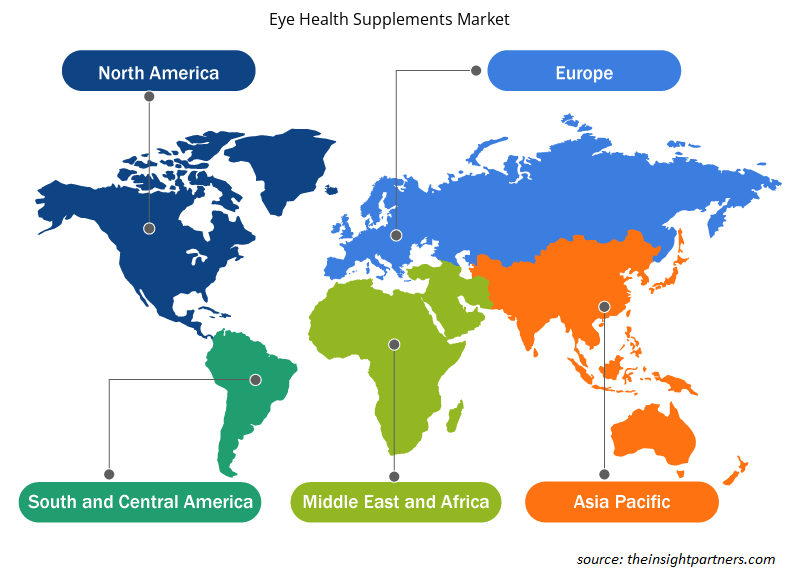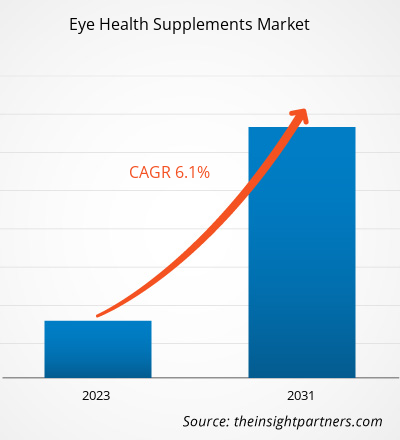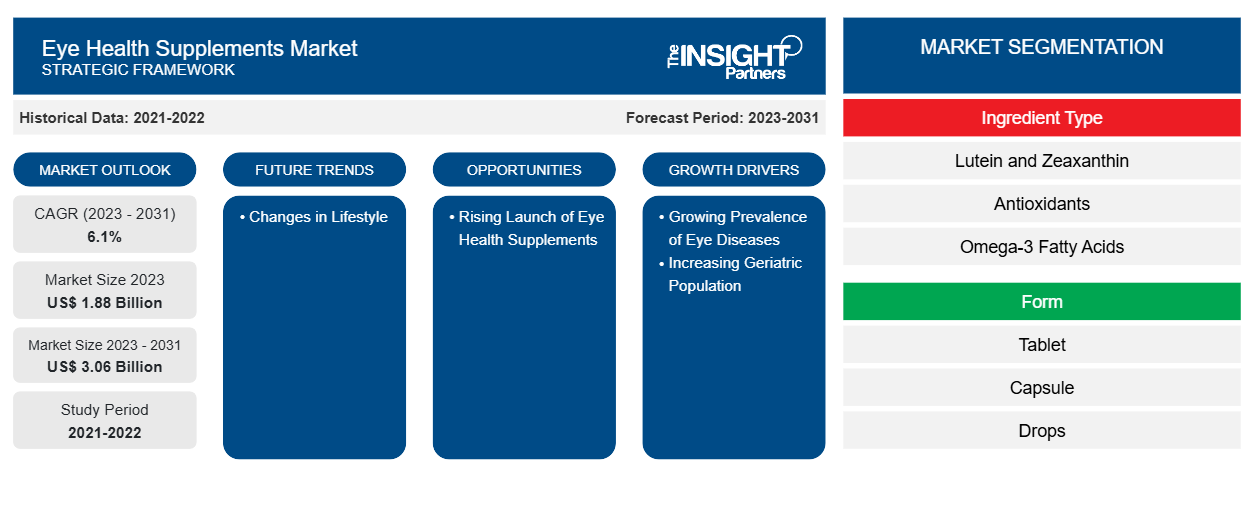Se proyecta que el tamaño del mercado de suplementos para la salud ocular alcance los 3.060 millones de dólares estadounidenses en 2031, frente a los 1.880 millones de dólares estadounidenses en 2023. Se espera que el mercado registre una CAGR del 6,1 % entre 2023 y 2031.
Es probable que el aumento de las enfermedades inducidas por el estilo de vida debido al mayor uso de teléfonos inteligentes, computadoras portátiles y computadoras siga siendo una tendencia clave en el mercado de suplementos para la salud ocular.
Análisis del mercado de suplementos para la salud ocular
El aumento del uso de pantallas y la participación en debates en línea mientras se trabaja desde casa ha aumentado la prevalencia de la miopía y la discapacidad visual. El mercado mundial de suplementos para la salud ocular está siendo impulsado por la creciente necesidad de productos para la salud ocular entre las personas mayores y la generación del milenio, que tienen más probabilidades de sufrir fatiga visual digital y miopía. Un aumento en la aparición de diversas afecciones oculares, incluida la inflamación, la enfermedad del ojo seco, las cataratas y la degeneración macular relacionada con la edad, está impulsando el crecimiento del mercado. Además, la ingesta de suplementos para la salud ocular mejora considerablemente la visión y la salud ocular, por lo que los oftalmólogos recomiendan suplementos para la salud ocular para prevenir y tratar estas afecciones. Se proyecta que los beneficios de los suplementos para la salud y sus componentes nutricionales asociados para tratar las afecciones oculares ofrecerán oportunidades lucrativas para el crecimiento del mercado de suplementos para la salud ocular.
Descripción general del mercado de suplementos para la salud ocular
Los suplementos para la salud ocular incluyen luteína y zeaxantina, ácidos grasos omega 3, vitamina A, ácido gamma-linolénico y otros. Estos suplementos nutricionales ayudan a mejorar la función ocular, reducen el desarrollo de enfermedades oculares relacionadas con la edad y protegen los ojos contra la luz dañina. Estos suplementos pueden ser beneficiosos para una variedad de enfermedades oculares, como enfermedades del ojo seco, degeneración macular relacionada con la edad, glaucoma , retinopatía diabética y cataratas. Según un estudio publicado por la Sociedad Canadiense de Oftalmología en 2020, alrededor de 1 millón de personas en Canadá padecen degeneración macular relacionada con la edad. Además, el envejecimiento de la población está a punto de convertirse en uno de los factores más importantes con un fuerte impacto en el nivel social y económico mundial. Según datos del Banco Mundial, la proporción de población geriátrica en Japón fue de alrededor del 28,4% en 2020. Según el informe Elderly in India de la Oficina Nacional de Estadística de 2021, se estima que la población de la India de 60 años o más alcanzará los 194 millones en 2031, frente a los 138 millones de 2021, lo que supone un aumento del 41%. La población que envejece es más susceptible a diversas enfermedades oculares; por ello, los oftalmólogos recomiendan el uso de suplementos para la salud ocular para la prevención y el tratamiento de estos trastornos, lo que a su vez impulsa el crecimiento del mercado. Se espera que el aumento de la población geriátrica aumente la demanda de suplementos para la salud ocular en la próxima década.
Personalice este informe según sus necesidades
Obtendrá personalización en cualquier informe, sin cargo, incluidas partes de este informe o análisis a nivel de país, paquete de datos de Excel, así como también grandes ofertas y descuentos para empresas emergentes y universidades.
-
Obtenga las principales tendencias clave del mercado de este informe.Esta muestra GRATUITA incluirá análisis de datos, desde tendencias del mercado hasta estimaciones y pronósticos.
Impulsores y oportunidades del mercado de suplementos para la salud ocular
La creciente prevalencia de enfermedades oculares impulsará el crecimiento del mercado
Se prevé que la creciente prevalencia de trastornos y anomalías oculares impulse la adopción de suplementos para la salud ocular. La degeneración macular relacionada con la edad, el glaucoma, las cataratas, las alergias oculares, la retinopatía diabética, la ambliopía y el estrabismo son trastornos oculares que se observan con frecuencia en la población mundial. Según los datos de National Glaucoma Research, se prevé que el número de personas que padecen glaucoma aumente de unos 80 millones en 2020 a unos 111 millones en 2040. Además, el 50% de las personas que padecen glaucoma desconocen su afección y el 90% de los casos de glaucoma en los países en desarrollo no se diagnostican. También es la principal causa de ceguera irreversible entre la población estadounidense y más de 3 millones de estadounidenses padecen glaucoma, según la Glaucoma Research Foundation.
Según el artículo de NCBI de 2021 titulado “Prevalencia mundial de la retinopatía diabética y proyección de la carga hasta 2045”, la cantidad de adultos con retinopatía diabética en todo el mundo fue de ~103,12 millones en 2020 y se espera que alcance ~160,50 millones para 2045. La ingesta de suplementos para la salud ocular mejora considerablemente la visión y la salud ocular y ciertos componentes nutricionales, como la vitamina A, la vitamina B, la vitamina C, la vitamina D, los ácidos grasos esenciales Omega-3, la luteína y la zeaxantina y el zinc, desempeñan un papel importante en la mejora de la salud ocular y la visión. Por lo tanto, se prevé que la alta prevalencia de afecciones oculares impulse la demanda y la adopción de suplementos para la salud ocular, impulsando así el crecimiento del mercado.
El creciente lanzamiento de suplementos para la salud ocular favorece el crecimiento del mercado
Se prevé que el mercado crezca a medida que se introduzcan más suplementos para la salud ocular para abordar las necesidades no satisfechas de los pacientes con discapacidad visual en todo el mundo. Se espera que esto impulse aún más las ventas de suplementos para la salud ocular en el futuro. Por ejemplo, Bausch + Lomb introdujo las cápsulas blandas PreserVision AREDS 2 Formula más coenzima Q10 (CoQ10) en el mercado estadounidense en 2023. Desarrolladas como una opción conveniente dos en uno, las vitaminas para los ojos PreserVision AREDS 2 Formula más CoQ10 son las únicas vitaminas para los ojos que combinan la fórmula de nutrientes exacta recomendada por el Instituto Nacional del Ojo para ayudar a reducir el riesgo de progresión de la degeneración macular relacionada con la edad de moderada a avanzada en pacientes con degeneración macular relacionada con la edad con CoQ10 para apoyar la salud cardíaca.
Análisis de segmentación del informe de mercado de suplementos para la salud ocular
Los segmentos clave que contribuyeron a la derivación del análisis del mercado de suplementos para la salud ocular son el tipo de ingrediente, la forma y la indicación.
- Según el tipo de ingrediente, el mercado de suplementos para la salud ocular se divide en luteína y zeaxantina, antioxidantes, ácidos grasos omega-3, coenzima Q10, flavonoides, astaxantina, ácido alfa lipoico y otros. El segmento de luteína y zeaxantina tuvo la mayor participación de mercado en 2023. Además, se prevé que el segmento de flavonoides registre la CAGR más alta durante el período de pronóstico.
- Por forma, el mercado está segmentado en tabletas, cápsulas y gotas. El segmento de cápsulas tuvo la mayor participación del mercado en 2023 y se proyecta que registre la CAGR más alta durante el período de pronóstico.
- En términos de indicación, el mercado se clasifica en degeneración macular relacionada con la edad, cataratas, síndrome del ojo seco y otros. El segmento de degeneración macular relacionada con la edad tuvo la mayor participación de mercado en 2023. Además, se prevé que el segmento del síndrome del ojo seco registre la CAGR más alta durante el período de pronóstico.
Análisis de la cuota de mercado de los suplementos para la salud ocular por geografía
El alcance geográfico del informe de mercado de suplementos para la salud ocular se divide principalmente en cinco regiones: América del Norte, Asia Pacífico, Europa, Medio Oriente y África, y América del Sur y Central.
América del Norte ha dominado el mercado de suplementos para la salud ocular. Según los datos de la Encuesta Nacional de Salud y Bienestar publicados en 2020, el 6,8% de la población adulta fue diagnosticada con enfermedad del ojo seco en los EE. UU. Debido a la creciente carga de enfermedades oculares como cataratas, glaucoma, retinopatía diabética y degeneración macular relacionada con la edad, la creciente población geriátrica, el creciente conocimiento de los productos y la presencia de actores importantes del mercado en la región, América del Norte representó la mayor participación en 2023. La creciente adopción de suplementos dietéticos y productos nutricionales, la implementación de programas de cuidado y salud ocular y la introducción en el mercado de nuevos productos son los factores clave que contribuyen al dominio del mercado de suplementos para la salud ocular de América del Norte. Se prevé que Asia Pacífico crezca con la CAGR más alta en los próximos años.
Noticias y desarrollos recientes del mercado de suplementos para la salud ocular
El mercado de suplementos para la salud ocular se evalúa mediante la recopilación de datos cualitativos y cuantitativos posteriores a la investigación primaria y secundaria, que incluye publicaciones corporativas importantes, datos de asociaciones y bases de datos. A continuación, se incluye una lista de los avances en el mercado de suplementos para la salud ocular y las estrategias:
- En enero de 2023, Bausch + Lomb Corporation anunció la introducción en EE. UU. de las minicápsulas blandas PreserVision AREDS 2 Formula con OCUSorb. Se ha demostrado clínicamente que OCUSorb, que ofrece una composición patentada de luteína y zeaxantina, proporciona una absorción superior de estos nutrientes en el cuerpo en comparación con la fórmula original de minicápsulas blandas PreserVision AREDS 2. (Fuente: Bausch + Lomb Corporation, comunicado de prensa, 2023)
Perspectivas regionales del mercado de suplementos para la salud ocular
Los analistas de Insight Partners explicaron en detalle las tendencias y los factores regionales que influyen en el mercado de suplementos para la salud ocular durante el período de pronóstico. Esta sección también analiza los segmentos y la geografía del mercado de suplementos para la salud ocular en América del Norte, Europa, Asia Pacífico, Oriente Medio y África, y América del Sur y Central.

- Obtenga datos regionales específicos para el mercado de suplementos para la salud ocular
Alcance del informe de mercado sobre suplementos para la salud ocular
| Atributo del informe | Detalles |
|---|---|
| Tamaño del mercado en 2023 | 1.880 millones de dólares estadounidenses |
| Tamaño del mercado en 2031 | US$ 3.06 mil millones |
| CAGR global (2023 - 2031) | 6,1% |
| Datos históricos | 2021-2022 |
| Período de pronóstico | 2023-2031 |
| Segmentos cubiertos |
Por tipo de ingrediente
|
| Regiones y países cubiertos |
América del norte
|
| Líderes del mercado y perfiles de empresas clave |
|
Densidad de actores del mercado de suplementos para la salud ocular: comprensión de su impacto en la dinámica empresarial
El mercado de suplementos para la salud ocular está creciendo rápidamente, impulsado por la creciente demanda de los usuarios finales debido a factores como la evolución de las preferencias de los consumidores, los avances tecnológicos y una mayor conciencia de los beneficios del producto. A medida que aumenta la demanda, las empresas amplían sus ofertas, innovan para satisfacer las necesidades de los consumidores y aprovechan las tendencias emergentes, lo que impulsa aún más el crecimiento del mercado.
La densidad de actores del mercado se refiere a la distribución de las empresas o firmas que operan dentro de un mercado o industria en particular. Indica cuántos competidores (actores del mercado) están presentes en un espacio de mercado determinado en relación con su tamaño o valor total de mercado.
Las principales empresas que operan en el mercado de suplementos para la salud ocular son:
- Naturales nórdicos
- Herbalife Nutrition Ltd
- La generosidad de la naturaleza
- AMWAY
- Pfizer Inc.
- Compañía Alcon Inc.
Descargo de responsabilidad : Las empresas enumeradas anteriormente no están clasificadas en ningún orden particular.

- Obtenga una descripción general de los principales actores clave del mercado de suplementos para la salud ocular
Informe sobre el mercado de suplementos para la salud ocular: cobertura y resultados
El informe “Tamaño y pronóstico del mercado de suplementos para la salud ocular (2023-2031)” proporciona un análisis detallado del mercado que cubre las siguientes áreas:
- Tamaño del mercado y pronóstico a nivel global, regional y nacional para todos los segmentos clave del mercado cubiertos bajo el alcance
- Dinámica del mercado, como impulsores, restricciones y oportunidades clave
- Principales tendencias futuras
- Análisis detallado de las cinco fuerzas de Porter y PEST y FODA
- Análisis del mercado global y regional que cubre las tendencias clave del mercado, los principales actores, las regulaciones y los desarrollos recientes del mercado.
- Análisis del panorama de la industria y de la competencia que abarca la concentración del mercado, el análisis de mapas de calor, los actores destacados y los desarrollos recientes
- Perfiles detallados de empresas
- Análisis histórico (2 años), año base, pronóstico (7 años) con CAGR
- Análisis PEST y FODA
- Tamaño del mercado, valor/volumen: global, regional y nacional
- Industria y panorama competitivo
- Conjunto de datos de Excel
Informes recientes
Informes relacionados
Testimonios
Razón para comprar
- Toma de decisiones informada
- Comprensión de la dinámica del mercado
- Análisis competitivo
- Información sobre clientes
- Pronósticos del mercado
- Mitigación de riesgos
- Planificación estratégica
- Justificación de la inversión
- Identificación de mercados emergentes
- Mejora de las estrategias de marketing
- Impulso de la eficiencia operativa
- Alineación con las tendencias regulatorias























 Obtenga una muestra gratuita para - Mercado de suplementos para la salud ocular
Obtenga una muestra gratuita para - Mercado de suplementos para la salud ocular